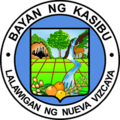Kasibu | |
|---|---|
| Municipality of Kasibu | |
 Municipal hall | |
 Map of Nueva Vizcaya with Kasibu highlighted | |
Location within the Philippines | |
| Coordinates: 16°19′05″N121°17′45″E / 16.3181°N 121.2958°E | |
| Country | Philippines |
| Region | Cagayan Valley |
| Province | Nueva Vizcaya |
| District | Lone district |
| Barangays | 30 (see Barangays) |
| Government | |
| • Type | Sangguniang Bayan |
| • Mayor | Romeo C. Tayaban |
| • Vice Mayor | Alberto D. Bumolo Jr. |
| • Representative | Luisa L. Cuaresma |
| • Electorate | 24,998 voters (2025) |
| Area | |
• Total | 318.80 km2 (123.09 sq mi) |
| Elevation | 873 m (2,864 ft) |
| Highest elevation | 1,248 m (4,094 ft) |
| Lowest elevation | 678 m (2,224 ft) |
| Population (2024 census) [3] | |
• Total | 46,845 |
| • Density | 146.94/km2 (380.58/sq mi) |
| • Households | 9,816 |
| Economy | |
| • Income class | 3rd municipal income class |
| • Poverty incidence | 19.66 |
| • Revenue | ₱ 313.8 million (2022) |
| • Assets | ₱ 843 million (2022) |
| • Expenditure | ₱ 242.2 million (2022) |
| • Liabilities | ₱ 129.7 million (2022) |
| Service provider | |
| • Electricity | Nueva Vizcaya Electric Cooperative (NUVELCO) |
| Time zone | UTC+8 (PST) |
| ZIP code | 3703 |
| PSGC | |
| IDD : area code | +63 (0)78 |
| Native languages | Ilocano Gaddang Bugkalot Tagalog |
Kasibu, officially the Municipality of Kasibu (Gaddang : Ili na Kasibu; Ilocano : Ili ti Kasibu; Tagalog : Bayan ng Kasibu), is a municipality in the province of Nueva Vizcaya, Philippines. According to the 2024 census, it has a population of 46,845 people. [5]







